
FuelCell Energy (FCEL)
We see potential in FuelCell Energy, but its cash burn shows it only has 18 months of runway left.― StockStory Analyst Team
1. News
2. Summary
Why FuelCell Energy Is Not Exciting
Founded in 1969, FuelCell Energy (NASDAQ: FCEL) is a leading manufacturer and developer of carbonate fuel cell technology for stationary power generation.
- Negative 19.4% gross margin means it loses money on every sale and must pivot or scale quickly to survive
- Poor expense management has led to operating margin losses
- Unfavorable liquidity position could lead to additional equity financing that dilutes shareholders


FuelCell Energy has some noteworthy aspects, but we wouldn’t invest until its EBITDA can comfortably service its debt.
Why There Are Better Opportunities Than FuelCell Energy
High Quality
Investable
Underperform
Why There Are Better Opportunities Than FuelCell Energy
FuelCell Energy’s stock price of $7.11 implies a valuation ratio of 0.9x forward price-to-sales. The market typically values companies like FuelCell Energy based on their anticipated profits for the next 12 months, but it expects the business to lose money. We also think the upside isn’t great compared to the potential downside here - there are more exciting stocks to buy.
We’d rather pay up for companies with elite fundamentals than get a bargain on poor ones. Cheap stocks can be value traps, and as their performance deteriorates, they will stay cheap or get even cheaper.
3. FuelCell Energy (FCEL) Research Report: Q2 CY2025 Update
Carbonate fuel cell technology developer FuelCell Energy (NASDAQ:FCEL) missed Wall Street’s revenue expectations in Q2 CY2025, but sales rose 97.3% year on year to $46.74 million. Its non-GAAP loss of $0.95 per share was 41.7% above analysts’ consensus estimates.
FuelCell Energy (FCEL) Q2 CY2025 Highlights:
- Revenue: $46.74 million vs analyst estimates of $49.58 million (97.3% year-on-year growth, 5.7% miss)
- Adjusted EPS: -$0.95 vs analyst estimates of -$1.63 (41.7% beat)
- Adjusted EBITDA: -$16.38 million vs analyst estimates of -$14.8 million (-35% margin, 10.7% miss)
- Operating Margin: -204%, down from -142% in the same quarter last year
- Backlog: $1.24 billion at quarter end, up 4% year on year
- Market Capitalization: $96.18 million
Company Overview
Founded in 1969, FuelCell Energy (NASDAQ: FCEL) is a leading manufacturer and developer of carbonate fuel cell technology for stationary power generation.
The company focuses on designing, manufacturing, and selling fuel cell power plants for distributed power generation, offering products ranging from 250 kW to 3 MW in capacity. FuelCell Energy's primary technology is the Direct FuelCell (DFC), which generates electricity directly from a hydrocarbon fuel by reforming it inside the fuel cell to produce hydrogen.
FuelCell Energy's products are designed to meet the power requirements of various customers, including utilities, industrial facilities, data centers, and other commercial and institutional buildings. The company's fuel cells offer several advantages over traditional power generation methods, including higher fuel efficiency, lower emissions, and the ability to use multiple fuel sources such as natural gas, biogas, and coal gas.
FuelCell Energy operates a manufacturing facility in Torrington, Connecticut, with a production capacity of 50 MW per year. The company has plans to expand this capacity to 150 MW within its current facility and potentially up to 400 MW with additional land access. FuelCell Energy also maintains a testing and conditioning facility in Danbury, Connecticut, capable of processing 50 MW of fuel cell power plants annually.
FuelCell Energy's financial performance has historically been heavily dependent on government funding. The company is working to transition towards more commercial sales as its products move closer to widespread market adoption.
4. Renewable Energy
Renewable energy companies are buoyed by the secular trend of green energy that is upending traditional power generation. Those who innovate and evolve with this dynamic market can win share while those who continue to rely on legacy technologies can see diminishing demand, which includes headwinds from increasing regulation against “dirty” energy. Additionally, these companies are at the whim of economic cycles, as interest rates can impact the willingness to invest in renewable energy projects.
Competitors of FuelCell Energy include Bloom Energy Corporation (NYSE: BE), Plug Power (NASDAQ:PLUG), and Ballard Power Systems (NASDAQ: BLDP).
5. Revenue Growth
Reviewing a company’s long-term sales performance reveals insights into its quality. Any business can put up a good quarter or two, but the best consistently grow over the long haul. Thankfully, FuelCell Energy’s 18.6% annualized revenue growth over the last five years was incredible. Its growth beat the average industrials company and shows its offerings resonate with customers.
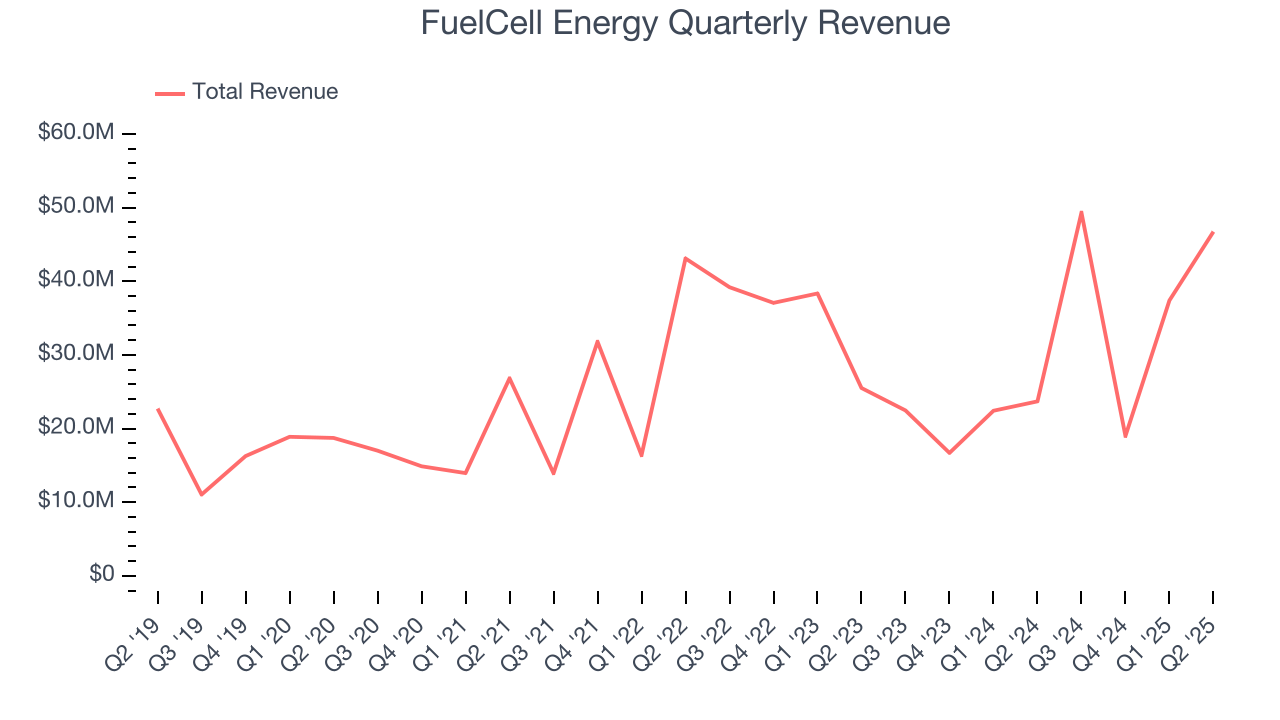
Long-term growth is the most important, but within industrials, a half-decade historical view may miss new industry trends or demand cycles. FuelCell Energy’s recent performance shows its demand has slowed significantly as its annualized revenue growth of 4.3% over the last two years was well below its five-year trend. We also note many other Renewable Energy businesses have faced declining sales because of cyclical headwinds. While FuelCell Energy grew slower than we’d like, it did do better than its peers. 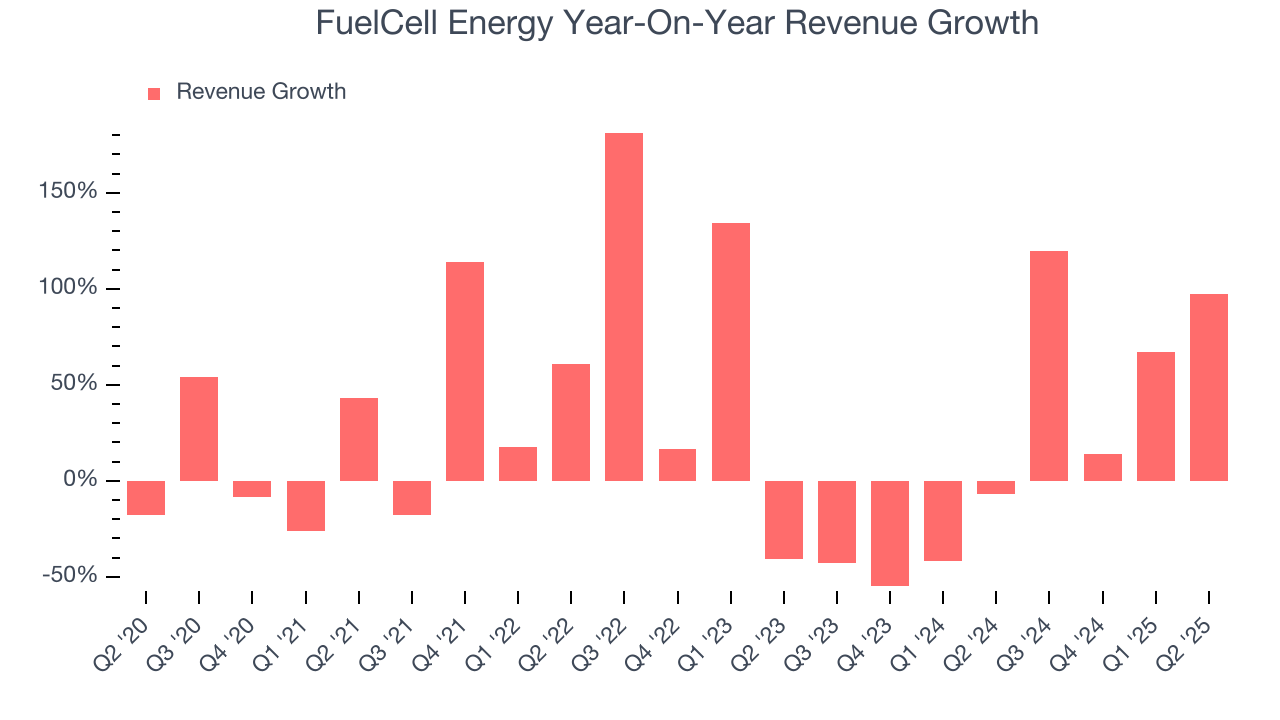
We can dig further into the company’s revenue dynamics by analyzing its backlog, or the value of its outstanding orders that have not yet been executed or delivered. FuelCell Energy’s backlog reached $1.24 billion in the latest quarter and averaged 8.9% year-on-year growth over the last two years. Because this number is better than its revenue growth, we can see the company accumulated more orders than it could fulfill and deferred revenue to the future. This could imply elevated demand for FuelCell Energy’s products and services but raises concerns about capacity constraints. 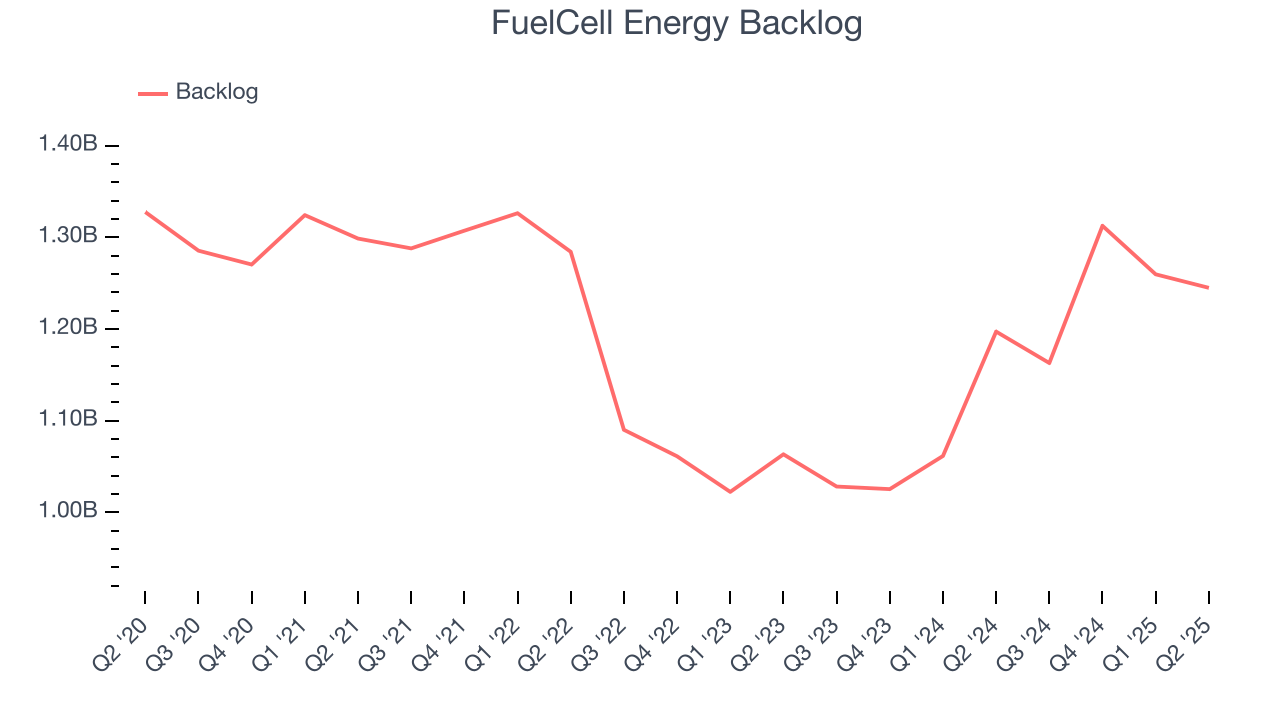
This quarter, FuelCell Energy achieved a magnificent 97.3% year-on-year revenue growth rate, but its $46.74 million of revenue fell short of Wall Street’s lofty estimates.
Looking ahead, sell-side analysts expect revenue to grow 35.7% over the next 12 months, an improvement versus the last two years. This projection is eye-popping and implies its newer products and services will spur better top-line performance.
6. Gross Margin & Pricing Power
FuelCell Energy has bad unit economics for an industrials business, signaling it operates in a competitive market. As you can see below, it averaged a negative 19.4% gross margin over the last five years. That means FuelCell Energy lost $19.43 for every $100 in revenue. 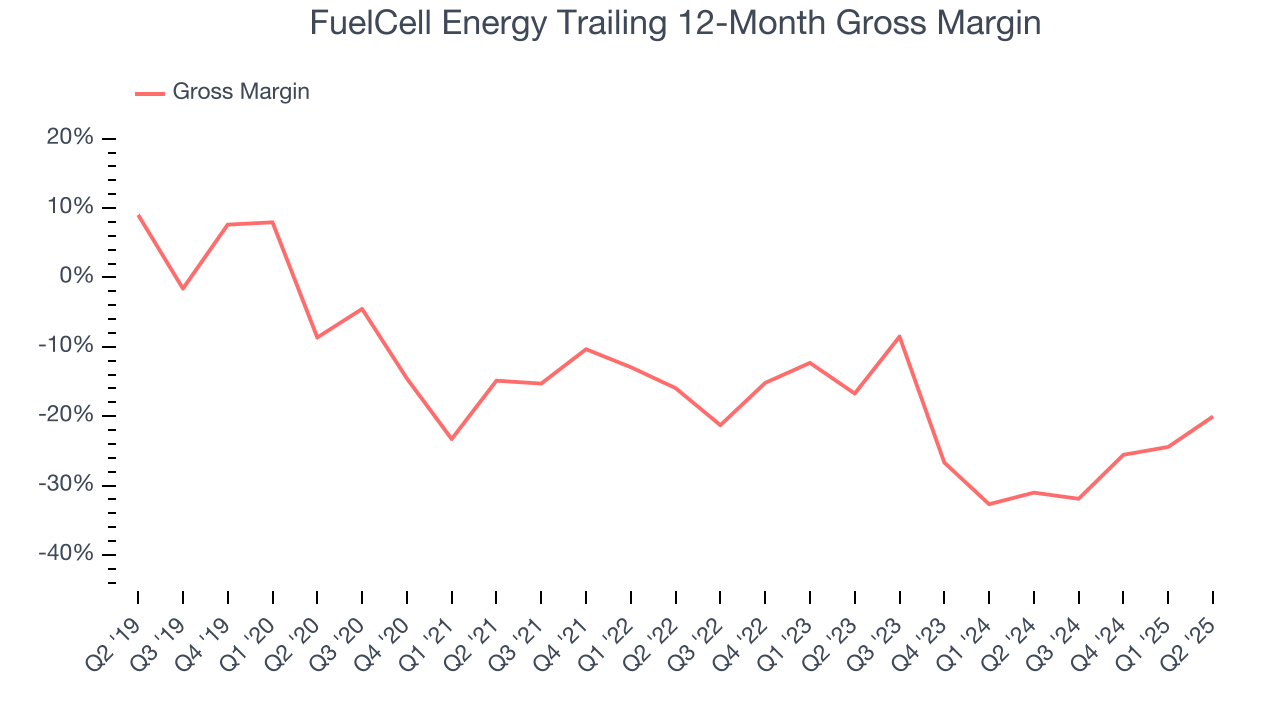
This quarter, FuelCell Energy’s gross profit margin was negative 11%. The company’s full-year margin was also negative, suggesting it needs to change its business model quickly.
7. Operating Margin
FuelCell Energy’s high expenses have contributed to an average operating margin of negative 123% over the last five years. Unprofitable industrials companies require extra attention because they could get caught swimming naked when the tide goes out. It’s hard to trust that the business can endure a full cycle.
Analyzing the trend in its profitability, FuelCell Energy’s operating margin decreased by 52.6 percentage points over the last five years. This raises questions about the company’s expense base because its revenue growth should have given it leverage on its fixed costs, resulting in better economies of scale and profitability. FuelCell Energy’s performance was poor no matter how you look at it - it shows that costs were rising and it couldn’t pass them onto its customers.

In Q2, FuelCell Energy generated a negative 204% operating margin.
8. Earnings Per Share
We track the long-term change in earnings per share (EPS) for the same reason as long-term revenue growth. Compared to revenue, however, EPS highlights whether a company’s growth is profitable.
Although FuelCell Energy’s full-year earnings are still negative, it reduced its losses and improved its EPS by 7.2% annually over the last five years. The next few quarters will be critical for assessing its long-term profitability. We hope to see an inflection point soon.
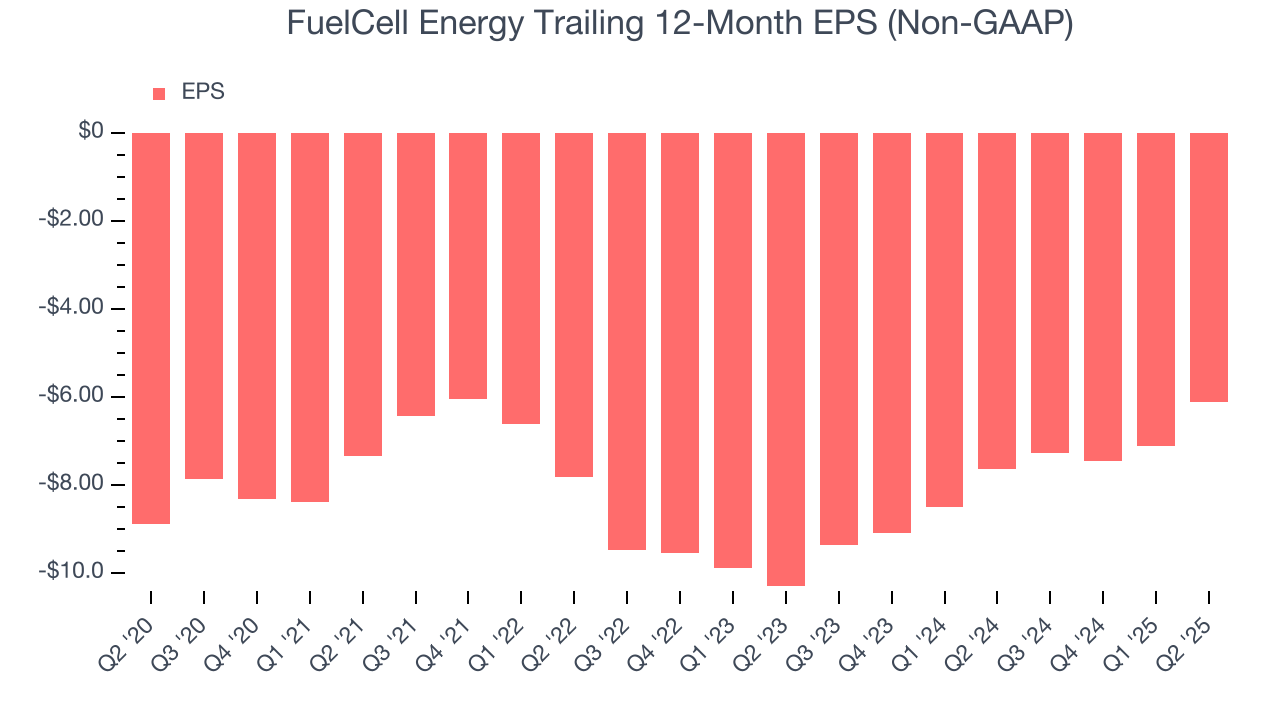
Like with revenue, we analyze EPS over a more recent period because it can provide insight into an emerging theme or development for the business.
For FuelCell Energy, its two-year annual EPS growth of 22.9% was higher than its five-year trend. Its improving earnings is an encouraging data point, but a caveat is that its EPS is still in the red.
In Q2, FuelCell Energy reported adjusted EPS of negative $0.95, up from negative $1.94 in the same quarter last year. This print easily cleared analysts’ estimates, and shareholders should be content with the results. Over the next 12 months, Wall Street expects FuelCell Energy to improve its earnings losses. Analysts forecast its full-year EPS of negative $6.12 will advance to negative $4.71.
9. Cash Is King
Although earnings are undoubtedly valuable for assessing company performance, we believe cash is king because you can’t use accounting profits to pay the bills.
FuelCell Energy’s demanding reinvestments have drained its resources over the last five years, putting it in a pinch and limiting its ability to return capital to investors. Its free cash flow margin averaged negative 136%, meaning it lit $135.68 of cash on fire for every $100 in revenue.
Taking a step back, an encouraging sign is that FuelCell Energy’s margin expanded by 31.4 percentage points during that time. In light of its glaring cash burn, however, this improvement is a bucket of hot water in a cold ocean.
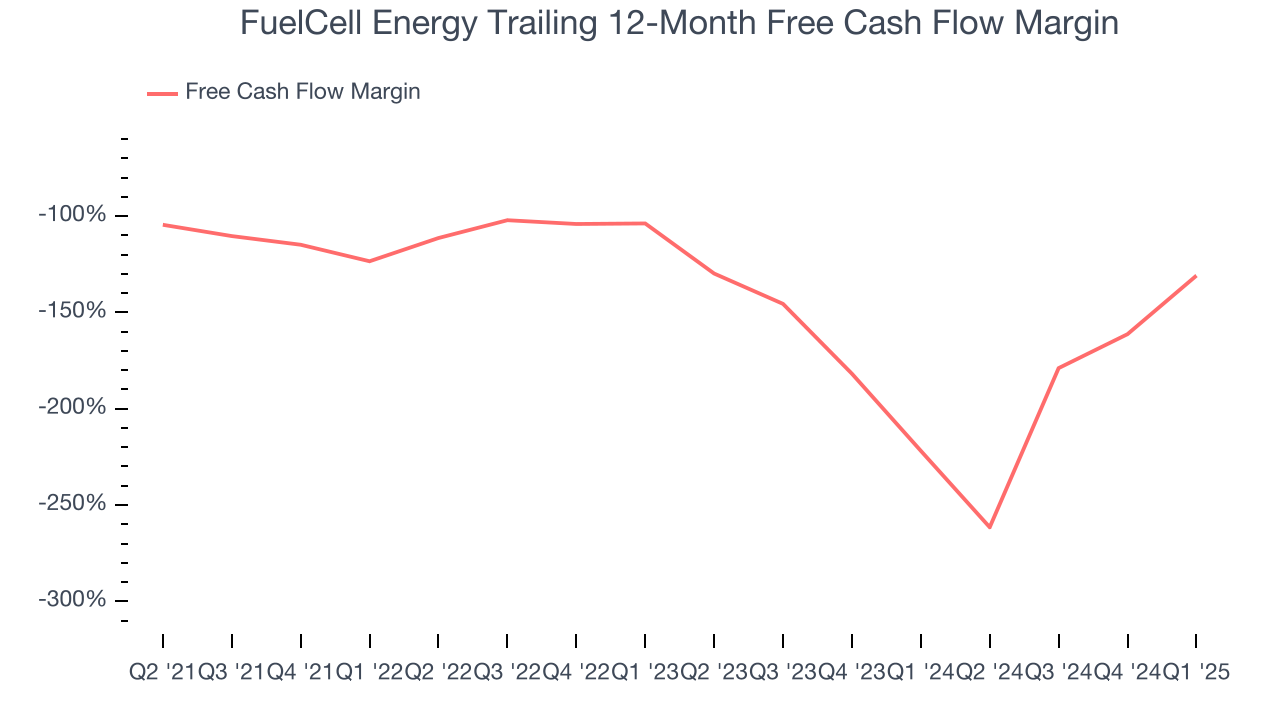
10. Balance Sheet Risk
As long-term investors, the risk we care about most is the permanent loss of capital, which can happen when a company goes bankrupt or raises money from a disadvantaged position. This is separate from short-term stock price volatility, something we are much less bothered by.
FuelCell Energy burned through $124.7 million of cash over the last year. With $190.8 million of cash on its balance sheet, the company has around 18 months of runway left (assuming its $136.8 million of debt isn’t due right away).
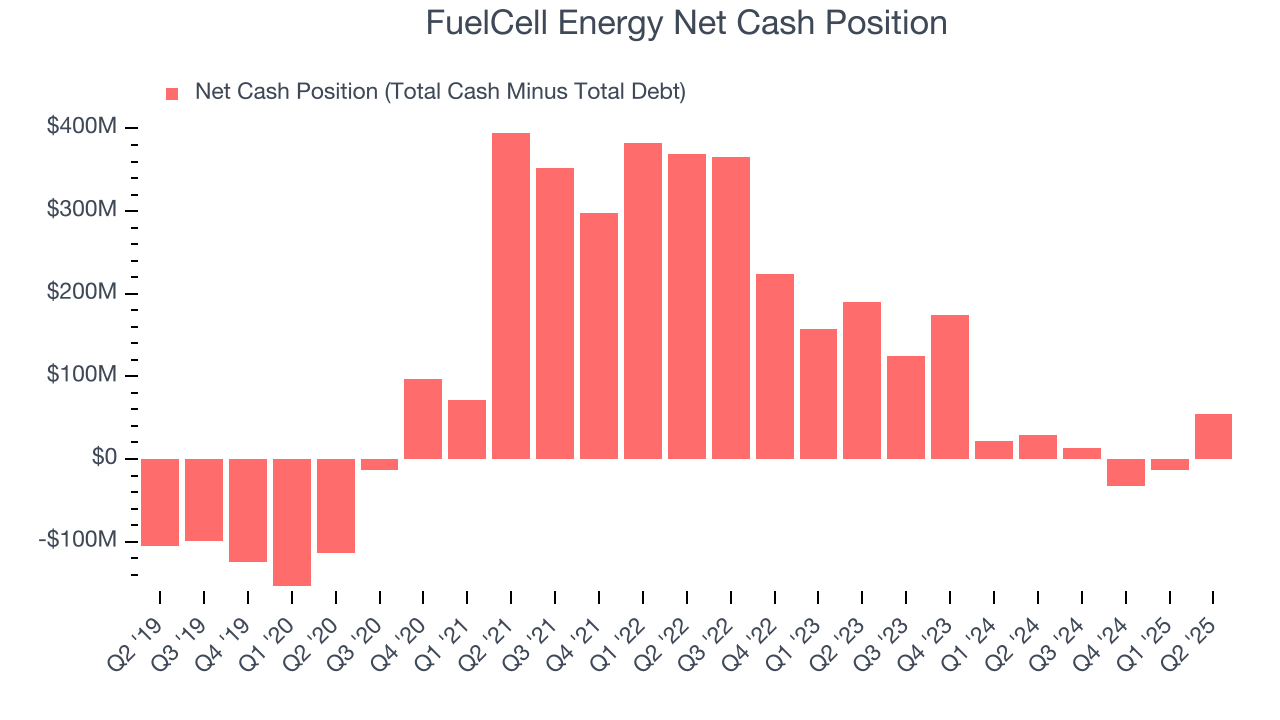
Unless the FuelCell Energy’s fundamentals change quickly, it might find itself in a position where it must raise capital from investors to continue operating. Whether that would be favorable is unclear because dilution is a headwind for shareholder returns.
We remain cautious of FuelCell Energy until it generates consistent free cash flow or any of its announced financing plans materialize on its balance sheet.
11. Key Takeaways from FuelCell Energy’s Q2 Results
It was good to see FuelCell Energy beat analysts’ EPS expectations this quarter. We were also glad its backlog outperformed Wall Street’s estimates. On the other hand, its revenue missed and its EBITDA fell short of Wall Street’s estimates. Zooming out, we think this was a mixed quarter. It seems that expectations were low, and the stock traded up 9.3% to $4.60 immediately following the results.
12. Is Now The Time To Buy FuelCell Energy?
Updated: December 3, 2025 at 10:42 PM EST
We think that the latest earnings result is only one piece of the bigger puzzle. If you’re deciding whether to own FuelCell Energy, you should also grasp the company’s longer-term business quality and valuation.
FuelCell Energy is a pretty decent company if you ignore its balance sheet. First off, its revenue growth was exceptional over the last five years and is expected to accelerate over the next 12 months. And while its declining operating margin shows the business has become less efficient, its rising cash profitability gives it more optionality. On top of that, its projected EPS for the next year implies the company’s fundamentals will improve.
FuelCell Energy’s forward price-to-sales ratio is 0.9x. Certain aspects of its fundamentals are attractive, but we aren’t investing at the moment because its balance sheet makes us uneasy. We think a potential buyer of the stock should wait until the company’s debt falls or its profits increase.
Wall Street analysts have a consensus one-year price target of $7.84 on the company (compared to the current share price of $7.11).








